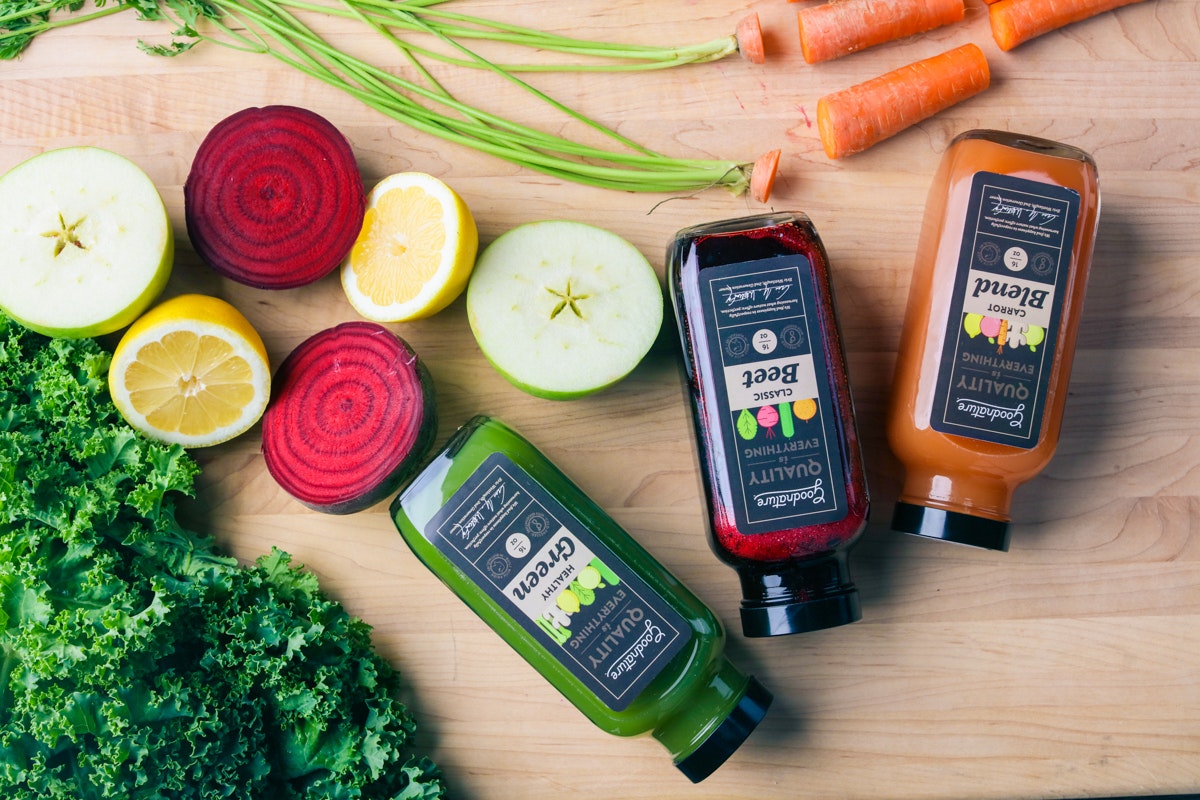I was in LA back in 2015, and my friend Adam was visiting from Australia to do some research about the juicing industry. I organized a factory tour for us of what was (at the time) the fastest growing, potentially most recognizable brand of cold-pressed juice in LA. I won’t mention the name, but let’s call it “Danger Juice”.
Note: This How to Write a Juice Business Plan PDF is a step-by-step guide to helping you write a business plan for your juice business. Download it for free!

We entered through the front office and into the production kitchen. It was very busy – at least 6-7 employees moving in different directions, pouring things, mixing liquids in big containers, measuring ingredients, pouring stuff into bottles. The staff were busy enough that most of them didn’t even bother to look up as we entered the kitchen to wander around and observe.
Being appreciative of the opportunity to see behind the scenes, we just kept to ourselves and smiled. However, in my mind I was thinking “there are major problems here.” Much of the raw juice was sitting in 5-gallon buckets at room temperature. There was no room for refrigeration inside, so they had rented a walk-in cooler that sat in the parking lot out back where they held the produce and finished bottles of juice. But everything inside was being operated at West LA temperatures – of which that day was probably about 75 degrees, and they were not moving it to cold storage quickly.
The reason that’s a problem is that microbes like bacteria grow rapidly in what is referred to as the “temperature danger zone” between 40 °F and 140 °F. In that temperature range, bacteria count can potentially double every twenty minutes. Allowing raw juice, and most other raw foods to sit in this “danger zone” can be, well, dangerous. The longer it sits in this zone the worse it can be. Allowing this to happen is what’s referred to as “time and temperature abuse”, and can greatly affect shelf life of juice.
When we exited the factory, I still hadn’t said anything. I wanted to wait and see if Adam had the same thoughts I did. Once we were about twenty feet from the door, he looked at me and said under his breath – “bro, what was that?”
Don’t be like Danger Juice, follow the below guidelines to keep your juice fresh.
Shelf Life
The term “shelf life” can mean a couple of different things in the juicing world. When someone asks, “how can I extend the shelf life of my juice?” Usually what they are asking about the sensory shelf life – meaning the color, taste, and separation of the juice. The other type of shelf life is microbial shelf life – basically, keeping the juice safe. For more in-depth reading on shelf life check out Understanding Shelf Life of Cold-Pressed Juice.
There are two keys to maintaining the best sensory and microbial shelf life and they are:
- Working in a clean environment.
- Avoiding time and temperature abuse.
Working in a Clean Environment
Working in a clean environment means, simply, that you are working with clean hands, clean surfaces, clean equipment, and clean food. All surfaces and equipment should be washed, rinsed, and sanitized at least every four hours. Hands should be washed frequently. Produce should be washed using an anti-microbial wash in cold water.
There is a method of analyzing one’s production process, defining all the points at which contamination might occur, and defining how contamination will be prevented and monitored. This is called a HACCP plan (Hazard Analysis Critical Control Points). Defining a HACCP plan is outside the scope of this article, but for more information, check out the FDA website.
HACCP plans aren’t usually required for single location juice bars, but it depends on your local health department. For help developing your own custom HACCP plan, schedule a free consultation with our juice business consultant.

Avoiding Time and Temperature Abuse
The single most important concept in running a juice business is keeping everything cold. The pros will keep their entire factory at 39 degrees, but most startups don’t have that ability. It is totally fine to work in a regular room-temperature factory as long as you have a clearly defined process to keep your product cold at every step.
Here are some tips to avoiding time and temperature abuse:
- Start with cold produce.
- Always wash the produce in cold water. Warm water can cook the produce and bring it into the temperature danger zone.
- Once the produce is clean, quickly move it to the juicing station and make juice.
- Once the juice is made, bottle it and return it to refrigeration ASAP. For more on this, read my article on How to Quickly Cool Down Juice.
- Never let the bottles of juice warm up beyond 39 F while transporting them to the customer.
Pro tip: Bottling the juice immediately after producing it allows you to seal the containers right away, and when you move the bottles to refrigeration it can actually cool down faster than if you keep the juice in a single, large container. In a large container of juice, the liquid near the center of the container may take several hours to cool down. In bottles, the cooling process is usually much faster.
If you are able to follow the basic advice above and avoid time and temperature abuse, you will see brighter colors, less separation, and fresher taste in your juice. Not to mention, you won’t see me writing about your business 10 years from now!

Comments
I juice at home you have shared some important info for me how to juice people. I juice celery everyday. And use a cold press juicer.
I always have been concerned how I am juicer. Is there a good book maybe you have written, that I can get good honest ways to juice and the benefits of juicing or non benefits like glucose spike! Thank You,
what anti-microbial wash do you recommend? A lot of the organic ones, regal, and FIT do not seem to say anti-microbial on.
Hi Laura,
Our chef recommends the wash from ecolab: https://www.ecolab.com/offerings/kitchen-maintenance/antimicrobial-fruit-and-vegetable-treatment
what about adding lemon juice to extend shelf life?
Yes adding an acidic juice can help a little bit. Please check out this article: Understanding Shelf Life of Cold-Pressed Juice
Micro Served Here
Hi! Awesome article. Question, I’m wondering how or where do I order a veggie/produce wash without being commercial? I’m trying to test it out. Any suggestions on where I can buy?
Hi Hollie,
You can order from webstaurantstore.com without having a commercial account. They have a veggie wash here: https://www.webstaurantstore.com/regal-foods-veggie-wash-fruit-and-vegetable-wash-1-gallon-container/999VEGWASH.html We recommend using ecolab's produce wash but it can be a little pricey, you might contact them to see if they offer samples: https://www.ecolab.com/offerings/kitchen-maintenance/antimicrobial-fruit-and-vegetable-treatment Hope this helps!
This article was everything. Simply written but deeply educational. As a new juice producer with all my knowledge and experience in juicing based on my personal research, personal health struggles (gluten intolerance & anemia), personally developed recipes... I love the heart of Goodnature Products Inc. You make it easy to get solid factual info that isn't easy or exactly safe to just get from google.
Thank you for your kind words! We do what we can to support the industry we love ❤️


Comment